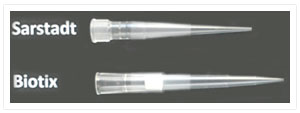What is the "Perfect Tip" for You?"

Figure 1: Image of 8-channel pipetting from Labcon web site.
What is the best pipet tip to use? The answer to this question lies within another question: "What are you going to be pipetting and what level of variability can you tolerate
in your results?" In other words, you should select the tip to fit the application. This is common sense that is not commonly applied.
What are the differences between tips?
Anyone with a plastic molding machine can make pipet tips by the millions. So this means there are two things that will make a difference:
- The type and quality of plastic.
- The quality and design of the mold.
Inexpensive plastic will yield tips that are often inconsistent in appearance as well as performance. Banana shaped tips are often seen. The quality and age of the mold used will
also have an impact. Molds only last so long and they need to be replaced at a cost that can exceed $100,000 each.
How does the mold affect tip performance?
When you pipet, any of the fluid that remains in the tip after it has been blown out is an error. If the same amount remains each time, then the precision will be good but the
accuracy won’t. So as a general rule, you don’t want anything to stay in the tip after a dispense cycle. When a mold is built, it is very highly polished. This yields pipet tips
with very smooth interior surfaces. As the mold ages, it wears. The wear is non-uniform. Over time, the interior surfaces become less smooth and thus provide more surface area
for material to adhere to thus decreasing both accuracy and precision.
One way for a tip manufacturer to lower costs is to extend the time between mold refurbishments. The more pipet tips you can produce between mold changes, the lower your cost
per tip to produce. Top tier manufacturers replace and refurbish their molds most often.
What are some other ways to get improved performance?
The first question is when do you need to improve performance? If all you are pipetting is water, then just about any pipet tip will do the job. Don’t waste your money looking
for a high performance tip. However if you are pipetting viscous materials such as proteins, serums and very expensive life science reagents used in DNA/RNA work, then using a
cheap pipet tip is like putting cooking oil in a race car – extremely false economy.
First, look for a tip that is made "slick" to begin with. Study the literature from the manufacturer. Next, you may wish to consider a siliconized (or other treated) tip. Siliconizing
the inner surface of a tip makes it really hydrophobic and slick. Avoid this if there is any potential for the silicon to be considered as a contaminant. Consider the shape and
length of the tip. Would a blunt, wide bore or beveled tip be better than a straight point tip for dispensing? Finally, train all of your lab workers to pipet correctly. The perfect
tip is of no use in the hands of someone who doesn’t know proper pipetting technique.
To Filter or Not – That is the Question

Figure 2: Photo showing both a filtered and non-filtered pipet tip.
Some pipet tips feature a filter barrier, such as the Biotix tip shown in Figure 2. This tip is, naturally, more expensive. These tips require racks and more expensive packaging.
There are wide variations in the filter material too. Some even have contamination indicators. But are they worth the added expense?
Many people feel that the barrier is a one-way device. Either it protects the sample against something getting into it from the pipettor or it prohibits the sample from getting
into the pipettor. The fact is, it should do both and in most cases it does. So when should you choose a filter tip?
- Any time you are worried about sample contamination from something that may be in the pipettor.
- For precious, high value samples so that they are always contained within the tip.
- To eliminate the possibility of microbiological or viral contamination of the sample.
- To protect the pipettor against harmful fluids or vapors such as strong acids or bases.
- For maximum reduction in cross-contamination between samples.
In summary, the perfect tip is one that is ideally suited to the sample you are pipetting and provides you with the quality of results you demand from the procedure you are performing.
The perfect tip in many cases will NOT be the cheapest or the most expensive tip. Only you can make that call.